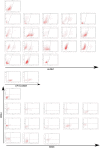Genetic profiling of putative breast cancer stem cells from malignant pleural effusions
- PMID: 28423035
- PMCID: PMC5396869
- DOI: 10.1371/journal.pone.0175223
Genetic profiling of putative breast cancer stem cells from malignant pleural effusions
Abstract
A common symptom during late stage breast cancer disease is pleural effusion, which is related to poor prognosis. Malignant cells can be detected in pleural effusions indicating metastatic spread from the primary tumor site. Pleural effusions have been shown to be a useful source for studying metastasis and for isolating cells with putative cancer stem cell (CSC) properties. For the present study, pleural effusion aspirates from 17 metastatic breast cancer patients were processed to propagate CSCs in vitro. Patient-derived aspirates were cultured under sphere forming conditions and isolated primary cultures were further sorted for cancer stem cell subpopulations ALDH1+ and CD44+CD24-/low. Additionally, sphere forming efficiency of CSC and non-CSC subpopulations was determined. In order to genetically characterize the different tumor subpopulations, DNA was isolated from pleural effusions before and after cell sorting, and compared with corresponding DNA copy number profiles from primary tumors or bone metastasis using low-coverage whole genome sequencing (SCNA-seq). In general, unsorted cells had a higher potential to form spheres when compared to CSC subpopulations. In most cases, cell sorting did not yield sufficient cells for copy number analysis. A total of five from nine analyzed unsorted pleura samples (55%) showed aberrant copy number profiles similar to the respective primary tumor. However, most sorted subpopulations showed a balanced profile indicating an insufficient amount of tumor cells and low sensitivity of the sequencing method. Finally, we were able to establish a long term cell culture from one pleural effusion sample, which was characterized in detail. In conclusion, we confirm that pleural effusions are a suitable source for enrichment of putative CSC. However, sequencing based molecular characterization is impeded due to insufficient sensitivity along with a high number of normal contaminating cells, which are masking genetic alterations of rare cancer (stem) cells.
Conflict of interest statement
Figures




References
MeSH terms
Substances
LinkOut - more resources
Full Text Sources
Other Literature Sources
Medical
Miscellaneous

